
Video Upload Options
Therizinosaurs (or segnosaurs) were theropod dinosaurs belonging to the clade Therizinosauria. Therizinosaur fossils have been found in Early through Late Cretaceous deposits in Mongolia, the China and western North America. Various features of the forelimbs, skull and pelvis unite these finds as both theropods and as maniraptorans, close relatives to birds. The name therizinosaur is derived from the Greek θερίζω therízein, meaning 'to reap' or 'to cut off', and σαῦρος saûros meaning 'lizard'. The older name segnosaur is derived from Latin segnis meaning 'slow' or 'sluggish', and Greek σαυρος, sauros, meaning 'lizard'.
1. Description
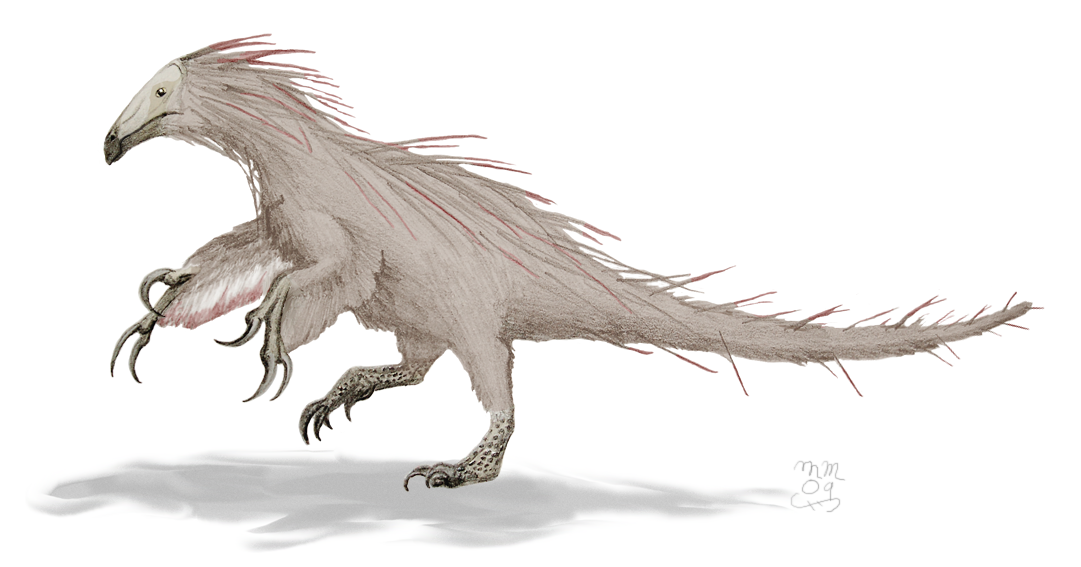
Therizinosaurs had a very distinctive, often confusing set of characteristics. Their long necks, wide torsos, and hind feet with four toes used in walking resembled those of basal sauropodomorph dinosaurs. Their unique hip bones, which pointed backwards and were partially fused together, initially reminded paleontologists of the "bird-hipped" ornithischians. Among the most striking characteristics of therizinosaurs are the enormous claws on their hands, which reached lengths of around one meter in Therizinosaurus. The unusual range of motion in therizinosaur forelimbs, which allowed them to reach forward to a degree other theropods could not achieve, also supports the idea that they were mainly herbivorous. Therizinosaurs may have used their long reach and strongly curved claws to grasp and shear leafy branches, in a manner similar to large mammals that lived later on, such as chalicotheres, ground sloths, great apes, and giant pandas.[1]
Skin impressions from Beipiaosaurus indicate that therizinosaurs were covered with a coat of primitive, down-like feathers similar to those seen in the compsognathid Sinosauropteryx, as well as longer, simpler, quill-like feathers that may have been used in display.[2][3] Therizinosaurs spanned a large range of sizes, from the small Beipiaosaurus (which measured 2.2 m [7 ft 3 in] in length),[4] to the gigantic Therizinosaurus, which at an approximate 10 m (33 ft) long and an estimated weight of 5 tonnes,[5] was among the largest-known theropods.
2. History of Research
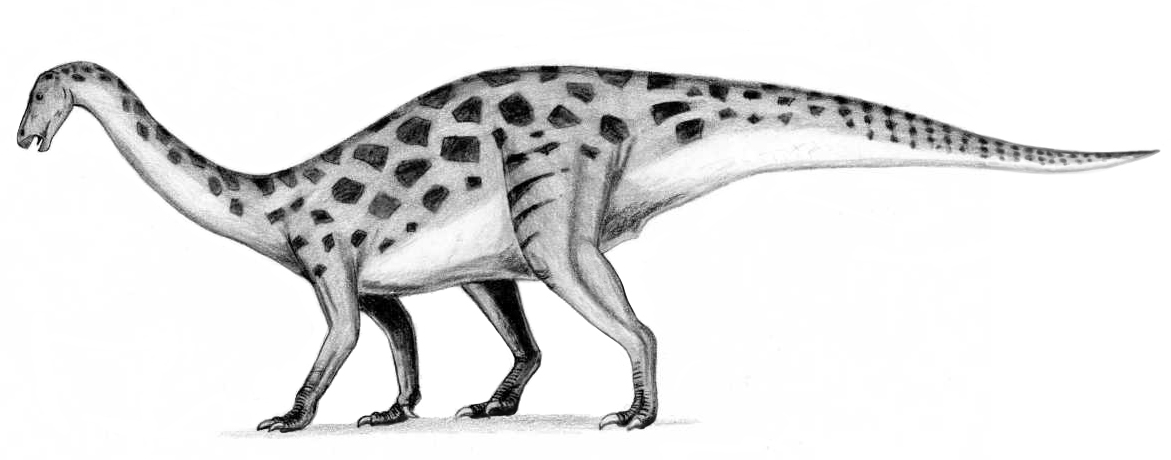
Because early finds were incomplete, the strange suite of anatomical features combining features typical of theropods, prosauropods and ornithischians led some scientists, such as Gregory S. Paul, to conclude that segnosaurs (as they were called before Therizinosaurus was recognized as part of the group) represented a late-surviving suborder of primitive dinosaurs, sometimes thought of as intermediates between prosauropods and ornithischians. Because of their suspected relationship with prosauropods, early depictions of segnosaurs (including illustrations by Paul) portrayed them as semi-quadrupedal, a mode of locomotion now known to have been impossible given the bird-like nature of their wrists.[6] It also led Paul to include segnosaurs within paleontologist Robert T. Bakker's Phytodinosauria in 1986, a superorder which was to include ornithischians, prosauropods, and sauropods, typified by their "blunt, spoon-crowned teeth suitable for cropping plants."[6]
It was not until the mid-1990s, after Alxasaurus was discovered and shown to possess more typically theropod features, and Therizinosaurus was recognized as a member of the segnosaur group, that their true identity as herbivorous descendants of the carnivorous theropods became generally accepted.[7] The relation between the more derived therizinosaurids and other theropods was greatly elucidated by the discovery of primitive members of the group, such as Beipiaosaurus in 1999 and Falcarius in 2005.[2] The scientists who described Falcarius noted that it seemed to represent an intermediate stage between carnivorous and herbivorous theropods, a sort of "missing link" between predatory maniraptorans and plant-eating therizinosaurs.[8] Although they are now classified as theropods, therizinosaurs had skulls similar to those of sauropods and the shape of their teeth and jaws make it likely that they were herbivores. <timeline> ImageSize = width:1200px height:auto barincrement:15px PlotArea = left:10px bottom:50px top:10px right:10px
Period = from:1824 till:2100 TimeAxis = orientation:horizontal ScaleMajor = unit:year increment:50 start:1824 ScaleMinor = unit:year increment:10 start:1824 TimeAxis = orientation:hor AlignBars = justify
Colors =
#legends id:CAR value:claret id:ANK value:rgb(0.4,0.3,0.196) id:HER value:teal id:HAD value:green id:OMN value:blue id:black value:black id:white value:white id:1900s value:rgb(0.94,0.25,0.24) id:2000s value:rgb(0.2,0.7,0.79) id:2000syears value:rgb(0.52,0.81,0.91) id:1900syears value:rgb(0.95,0.56,0.45) id:1700s value:rgb(0.5,0.78,0.31) id:1700syears value:rgb(0.63,0.78,0.65) id:latecretaceous value:rgb(0.74,0.82,0.37) id:1800syears value:rgb(0.95,0.98,0.11) id:paleogene value:rgb(0.99,0.6,0.32) id:paleocene value:rgb(0.99,0.65,0.37) id:eocene value:rgb(0.99,0.71,0.42) id:oligocene value:rgb(0.99,0.75,0.48) id:1800s value:rgb(0.999999,0.9,0.1) id:miocene value:rgb(0.999999,0.999999,0) id:pliocene value:rgb(0.97,0.98,0.68) id:quaternary value:rgb(0.98,0.98,0.5) id:pleistocene value:rgb(0.999999,0.95,0.68) id:holocene value:rgb(0.999,0.95,0.88)
BarData=
bar:eratop bar:space bar:periodtop bar:space bar:NAM1 bar:NAM2 bar:NAM3 bar:NAM4 bar:NAM5 bar:NAM6 bar:NAM7 bar:NAM8 bar:space bar:period bar:space bar:era
PlotData=
align:center textcolor:black fontsize:M mark:(line,black) width:25 shift:(7,-4)
bar:periodtop from: 1824 till: 1830 color:1800syears text:20s from: 1830 till: 1840 color:1800syears text:30s from: 1840 till: 1850 color:1800syears text:40s from: 1850 till: 1860 color:1800syears text:50s from: 1860 till: 1870 color:1800syears text:60s from: 1870 till: 1880 color:1800syears text:70s from: 1880 till: 1890 color:1800syears text:80s from: 1890 till: 1900 color:1800syears text:90s from: 1900 till: 1910 color:1900syears text:00s from: 1910 till: 1920 color:1900syears text:10s from: 1920 till: 1930 color:1900syears text:20s from: 1930 till: 1940 color:1900syears text:30s from: 1940 till: 1950 color:1900syears text:40s from: 1950 till: 1960 color:1900syears text:50s from: 1960 till: 1970 color:1900syears text:60s from: 1970 till: 1980 color:1900syears text:70s from: 1980 till: 1990 color:1900syears text:80s from: 1990 till: 2000 color:1900syears text:90s from: 2000 till: 2010 color:2000syears text:00s from: 2010 till: 2020 color:2000syears text:10s from: 2020 till: 2030 color:2000syears text:20s from: 2030 till: 2040 color:2000syears text:30s from: 2040 till: 2050 color:2000syears text:40s from: 2050 till: 2060 color:2000syears text:50s from: 2060 till: 2070 color:2000syears text:60s from: 2070 till: 2080 color:2000syears text:70s from: 2080 till: 2090 color:2000syears text:80s from: 2090 till: 2100 color:2000syears text:90s
bar:eratop from: 1824 till: 1900 color:1800s text:19th from: 1900 till: 2000 color:1900s text:20th from: 2000 till: 2100 color:2000s text:21st
PlotData=
align:left fontsize:M mark:(line,white) width:5 anchor:till align:left
color:1900s bar:NAM3 at:2005 mark:(line,black) text:Falcarius color:1900s bar:NAM1 at:2013 mark:(line,black) text:Jianchangosaurus color:1900s bar:NAM6 at:1999 mark:(line,black) text:Beipiaosaurus color:1900s bar:NAM5 at:1994 mark:(line,black) text:Alxasaurus color:1900s bar:NAM2 at:2002 mark:(line,black) text:Erliansaurus color:1800s bar:NAM1 at:1979 mark:(line,black) text:Nanshiungosaurus color:1900s bar:NAM7 at:2001 mark:(line,black) text:Neimongosaurus color:1900s bar:NAM2 at:1979 mark:(line,black) text:Segnosaurus color:1800s bar:NAM3 at:1980 mark:(line,black) text:Erlikosaurus color:1800s bar:NAM4 at:2007 mark:(line,black) text:Suzhousaurus color:1900s bar:NAM4 at:1983 mark:(line,black) text:Enigmosaurus color:1800s bar:NAM1 at:1954 mark:(line,black) text:Therizinosaurus color:1900s bar:NAM8 at:2001 mark:(line,black) text:Nothronychus
PlotData=
align:center textcolor:black fontsize:M mark:(line,black) width:25
bar:period from: 1824 till: 1830 color:1800syears text:20s from: 1830 till: 1840 color:1800syears text:30s from: 1840 till: 1850 color:1800syears text:40s from: 1850 till: 1860 color:1800syears text:50s from: 1860 till: 1870 color:1800syears text:60s from: 1870 till: 1880 color:1800syears text:70s from: 1880 till: 1890 color:1800syears text:80s from: 1890 till: 1900 color:1800syears text:90s from: 1900 till: 1910 color:1900syears text:00s from: 1910 till: 1920 color:1900syears text:10s from: 1920 till: 1930 color:1900syears text:20s from: 1930 till: 1940 color:1900syears text:30s from: 1940 till: 1950 color:1900syears text:40s from: 1950 till: 1960 color:1900syears text:50s from: 1960 till: 1970 color:1900syears text:60s from: 1970 till: 1980 color:1900syears text:70s from: 1980 till: 1990 color:1900syears text:80s from: 1990 till: 2000 color:1900syears text:90s from: 2000 till: 2010 color:2000syears text:00s from: 2010 till: 2020 color:2000syears text:10s from: 2020 till: 2030 color:2000syears text:20s from: 2030 till: 2040 color:2000syears text:30s from: 2040 till: 2050 color:2000syears text:40s from: 2050 till: 2060 color:2000syears text:50s from: 2060 till: 2070 color:2000syears text:60s from: 2070 till: 2080 color:2000syears text:70s from: 2080 till: 2090 color:2000syears text:80s from: 2090 till: 2100 color:2000syears text:90s
bar:era from: 1824 till: 1900 color:1800s text:19th from: 1900 till: 2000 color:1900s text:20th from: 2000 till: 2100 color:2000s text:21st
</timeline>
3. Systematics

5.1. Taxonomy
Barsbold and Perle named the group Segnosauria as an infraorder of Theropoda in 1980.[9] Dong Zhiming (1992) went further, placing the segnosaurs in their own order, Segnosaurischia. This name has been abandoned since the discovery that segnosaurs are a specialized group within the suborder Theropoda. Clark et al. in 2004 considered Segnosaurischia a synonym of Therizinosauroidea.
The superfamily Therizinosauroidea had been established by Maleev in 1954, to include only the bizarre, giant-clawed theropod Therizinosaurus. When it was later realized that Therizinosaurus was an advanced segnosaur, Therizinosauroidea was given a phylogenetic definition to include both groups, and has largely replaced the use of the older name Segnosauria in phylogenetic studies, mainly because of the association of the name Segnosauria with the discredited idea that these animals were relatives of prosauropods.
The following taxonomy follows Zanno, 2010 unless otherwise noted.[10]
- Branch Therizinosauria
- Genus Eshanosaurus? (could be relative of Chilesaurus[11])
- Genus Falcarius
- Genus Martharaptor
- Genus Jianchangosaurus (Pu et al., 2013)
- Superfamily Therizinosauroidea
- Genus Beipiaosaurus
- Genus Enigmosaurus
- Genus Erliansaurus
- Genus Neimongosaurus
- Genus Suzhousaurus
- Family Alxasauridae
- Family Therizinosauridae
5.2. Phylogeny
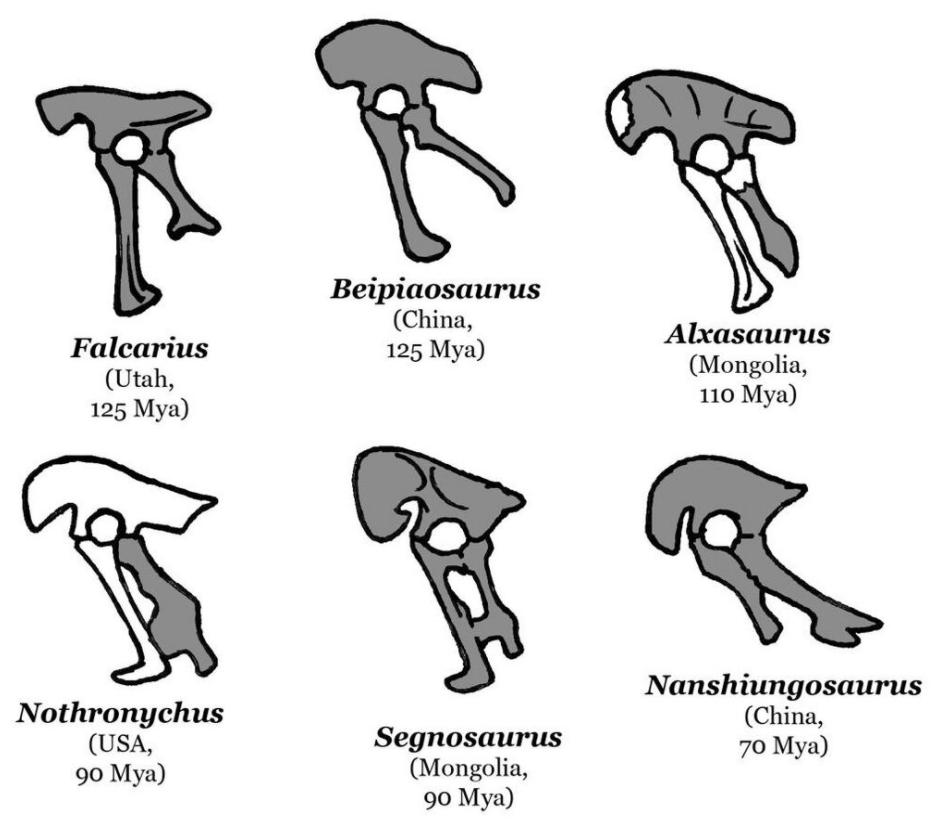
The clade Therizinosauria was first defined by Dale Russell in 1997 as Alxasaurus, Enigmosaurus, Erlikosaurus, Nanshiungosaurus, Segnosaurus, Therizinosaurus, and all taxa closer to them than to oviraptorosaurs, ornithomimids, and troodontids. Paul Sereno, in 2005, modified this definition to the most inclusive clade containing Therizinosaurus but not Ornithomimus, Oviraptor, Shuvuuia, Tyrannosaurus, or Troodon.[12]
Therizinosauroidea, previously named as a superfamily with no phylogenetic definition, was first defined by Zhang et al. in 2001, as the clade containing all theropods more closely related to Therizinosaurus than to birds (effectively replacing the older name Segnosauria, which has not yet been defined as a clade). This definition, however, defines the same group as the pre-existing Therizinosauria. An alternate definition was given by Clark in 2004 (as the last common ancestor of Therizinosaurus and Beipiaosaurus and all its descendants), comprising a narrower group that excludes more primitive therizinosaurs, such as Falcarius, and allows the name Therizinosauria to remain in use for the larger group comprising all therizinosaurs. This definition was followed by Teresa Maryańska and Barsbold (2004), Sereno (2005), Zanno et al. (2009) and Zanno (2010),[10][12][13][14] though other subsequent studies, such as Senter (2007, 2012) have continued to use Therizinosauroidea for the therizinosaur "total group".[15]
The following cladogram follows an analysis by Phil Senter, 2007.[15]
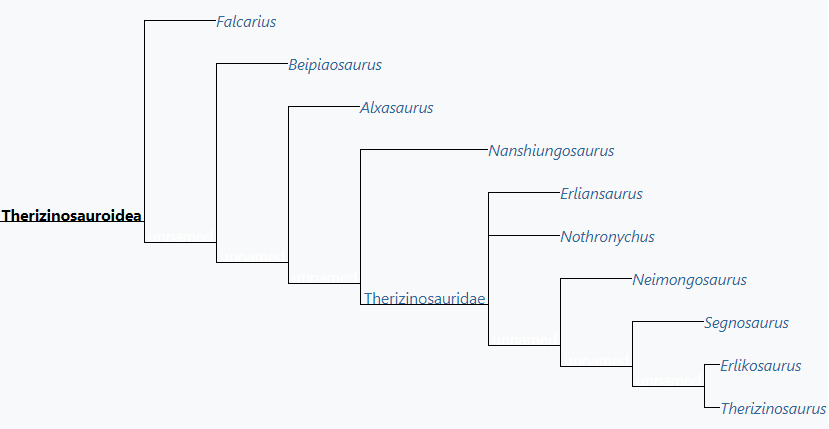
The cladogram below follows the extensive phylogenetic analysis of Therizinosauria, by Lindsay E. Zanno, 2010.
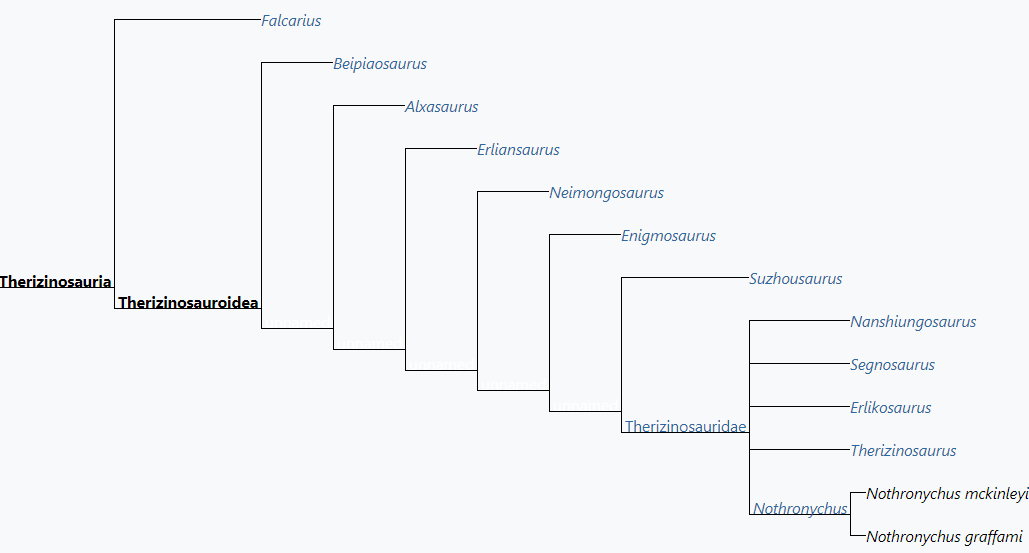
The following cladogram is based on the phylogenetic analysis by Phil Senter et al., 2012.[16]
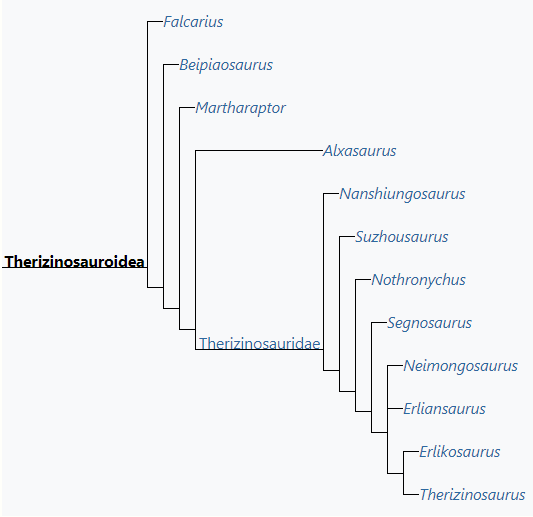
The cladogram below is the most recent cladogram based on the phylogenetic analysis of Therizinosauria conducted by Hanyong Pu et al., 2013.[17]
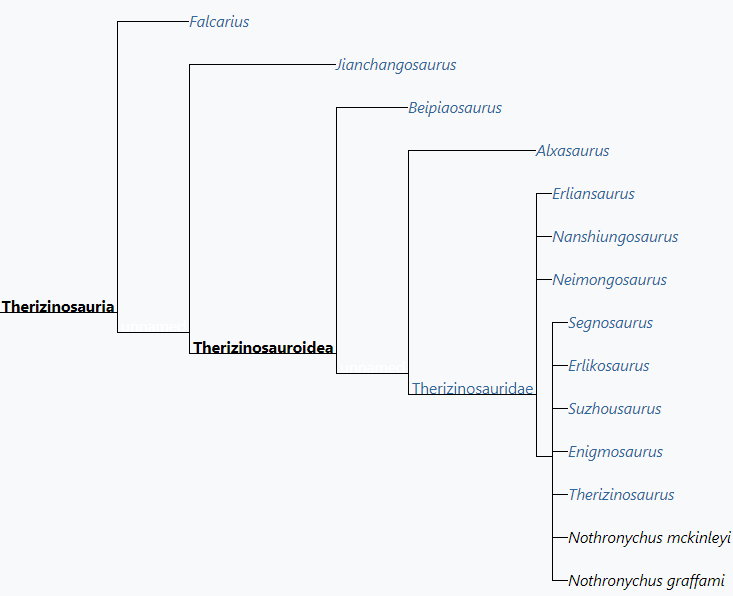
5.3. Paleobiology
Therizinosauroid behavior is quite poorly understood, but 20th-century studies and subsequent finds have revealed some aspects of their behavior. Nests with sub-spherical eggs have been found, and evidence points to the eggs being buried and abandoned by the parents. And studies of neonates indicate they were well developed and likely precocial—able to leave the nest shortly after birth and suggesting little to no parental care.[18]
CT scans published in 2012 by Stephan Lautenschlager et al. focused on the skull and brain cavity of Erlikosaurus, revealing it to have a large forebrain, and suggesting it had well developed senses of balance, hearing and smell, all of which would have been useful in evading predators, finding food, or in performng complex social behavior.[19]
In 2011, a nesting ground containing 17 clutches of eggs was found in Mongolia's Gobi Desert, with a total of 75 eggs uncovered during excavation. The eggs were 5 inches in diameter and contained no embryos; and there was evidence—in the form of egg shells that had been broken out of—that the young had hatched and left, presumably with their parents. The presence of so many fossilized eggs in one venue implies that therizinosaurs probably were social animals that came together for nesting; and that some genera may have performed parental care. This find, described by Yoshitsugu Kobayashi et al., and mass-death quarries such as those containing Falcarius, augments evidence that therizinosauroids were social, herding animals. Adult therizinosaurs are estimated to have weighed around 500 kg (1,100 lb).[20][21]
References
- * Burch, S. (2006). "The range of motion of the glenohumeral joint of the therizinosaur Neimongosaurus yangi (Dinosauria: Theropoda)." Chicago Biological Investigator, 3(2): 20. (Abstract).
- Xu, X.; Tang, Z-L.; Wang, X-L. (1999). "A therizinosauroid dinosaur with integumentary structures from China". Nature 399 (6734): 350–354. doi:10.1038/20670. Bibcode: 1999Natur.399..350X. https://dx.doi.org/10.1038%2F20670
- Xu X., Zheng X.-t. and You, H.-l. (2009). "A new feather type in a nonavian theropod and the early evolution of feathers." Proceedings of the National Academy of Sciences (Philadelphia), . doi:10.1073/pnas.0810055106 PMID 19139401 https://doi.org/10.1073%2Fpnas.0810055106
- Xu, X.; Tang, Z-L.; Wang, X-L. (1999). "A therizinosauroid dinosaur with integumentary structures from China". Nature 399 (6734): 350–354. doi:10.1038/20670. Bibcode: 1999Natur.399..350X. https://dx.doi.org/10.1038%2F20670
- Paul, G.S., 2010, The Princeton Field Guide to Dinosaurs, Princeton University Press p. 160
- Paul, G.S. (1988). Predatory Dinosaurs of the World, a Complete Illustrated Guide. New York: Simon and Schuster. 464 p.
- null
- Kirkland, J.I.; Zanno, L.E.; Sampson, S.D.; Clark, J.M.; DeBlieux, D.D. (2005). "A primitive therizinosauroid dinosaur from the Early Cretaceous of Utah". Nature 435 (7038): 84–87. doi:10.1038/nature03468. PMID 15875020. Bibcode: 2005Natur.435...84K. https://dx.doi.org/10.1038%2Fnature03468
- null
- Lindsay E. Zanno (2010). "A taxonomic and phylogenetic re-evaluation of Therizinosauria (Dinosauria: Maniraptora)". Journal of Systematic Palaeontology 8 (4): 503–543. doi:10.1080/14772019.2010.488045. http://www.tandfonline.com/doi/abs/10.1080/14772019.2010.488045.
- Paul, G. S. (2016). The Princeton field guide to dinosaurs, second edition. Princeton University Press.
- Sereno, P. C. 2005. Stem Archosauria—TaxonSearch [version 1.0, 2005 November 7] http://www.taxonsearch.org/Archive/stem-archosauria-1.0.php
- Clark, J.M., Maryanska, T., and Barsbold, R. (2004). "Therizinosauroidea." Pp. 151– 164 in Weishampel, D.B., Dodson, P., and Osmólska, H. (eds.). The Dinosauria, Second Edition. University of California Press., 861 pp.
- Zanno, L.E., Gillette, D.D., Albright, L.B., and Titus, A.L. (2009). "A new North American therizinosaurid and the role of herbivory in 'predatory' dinosaur evolution." Proceedings of the Royal Society B, Published online before print July 15, 2009, doi:10.1098/rspb.2009.1029. https://doi.org/10.1098%2Frspb.2009.1029
- Senter, P. (2007). "A new look at the phylogeny of Coelurosauria (Dinosauria: Theropoda)." Journal of Systematic Palaeontology, 5: 429-463 (doi:10.1017/S1477201907002143). https://doi.org/10.1017%2FS1477201907002143
- Senter, P.; Kirkland, J. I.; Deblieux, D. D. (2012). Dodson, Peter. ed. "Martharaptor greenriverensis, a New Theropod Dinosaur from the Lower Cretaceous of Utah". PLoS ONE 7 (8): e43911. doi:10.1371/journal.pone.0043911. PMID 22952806. Bibcode: 2012PLoSO...743911S. http://www.pubmedcentral.nih.gov/articlerender.fcgi?tool=pmcentrez&artid=3430620
- Pu, H.; Kobayashi, Y.; Lü, J.; Xu, L.; Wu, Y.; Chang, H.; Zhang, J.; Jia, S. (2013). Claessens, Leon. ed. "An Unusual Basal Therizinosaur Dinosaur with an Ornithischian Dental Arrangement from Northeastern China". PLoS ONE 8 (5): e63423. doi:10.1371/journal.pone.0063423. PMID 23734177. Bibcode: 2013PLoSO...863423P. http://www.pubmedcentral.nih.gov/articlerender.fcgi?tool=pmcentrez&artid=3667168
- Paul, G.S. (2010). The Princeton Field Guide to Dinosaurs. Princeton University Press. p. 157.
- "Inside the head of a dinosaur: Research reveals new information on the evolution of dinosaur senses". ScienceDaily. https://www.sciencedaily.com/releases/2012/12/121219174154.htm.
- "Nests of Big-Clawed Dinosaurs Found in Mongolia". Yahoo News. 5 November 2013. https://news.yahoo.com/nests-big-clawed-dinosaurs-found-mongolia-123729403.html.
- "Nests of Big-Clawed Dinosaurs Found in Mongolia". LiveScience.com. http://www.livescience.com/40904-therizinosaur-nesting-colony-discovered.html.




